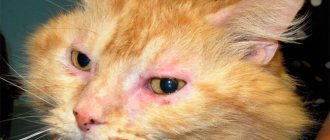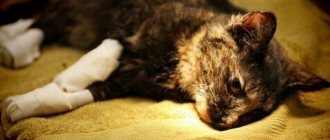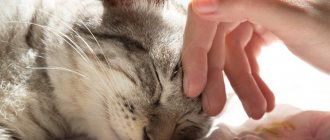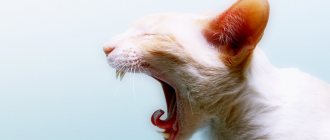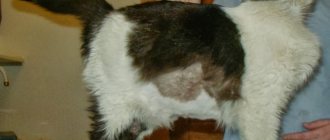Why is hyperthyroidism dangerous?
Thyroid hormones T4 and T3 have a great influence on the proper growth and development of body cells, regulate the metabolism of proteins, fats and carbohydrates, as well as heat exchange and oxygen consumption, that is, they are involved in a wide range of metabolic processes.
Excess of these hormones significantly increases the metabolic rate. Because of this, all systems function at an accelerated pace, and the body is not always able to support this. As a result, problems with blood pressure, heart, kidneys, liver, musculoskeletal system, and gastrointestinal tract may occur. One of the serious consequences of hyperthyroidism is the development of cardiovascular diseases.
What is hyperthyroidism
Hyperthyroidism (from the Latin hyper - exceeding, thyroid - thyroid gland) is an endocrine disease when the thyroid gland in cats performs its hyperfunction. Pathology may affect one or both lobes of the gland. Thyroid hormones influence the growth, development and division of tissues. Unlike humans, in cats the disease in almost 90% of cases is associated with autonomous hyperfunction of the gland.
Cat with hyperthyroidism
With this disease, the presence of hormones in the body increases, such as thyroxine and triiodothyronine. This disorder leads to a deterioration in the animal’s metabolism. Other names for the disease are thyroidectomy and thyrotoxicosis. There is a lecture on this topic from Vetfarm specialist Mikhail Mikhailovich Belenson.
Important! Hypothyroidism in cats is a completely different disease. Hypo is a prefix meaning deficiency. Therefore, hypothyroidism manifests symptoms in cats differently. These are excess weight gain, hypothermia, slow metabolism and pulse. Hypothyroidism in cats affects gradually, just like its opposite disease.
It is not clear which breed of cat this disease is most pronounced in. There is also no difference by gender - both male and female cats can be at risk.
Symptoms of hyperthyroidism
Since metabolism speeds up and the body requires more energy to function normally, a cat with hyperthyroidism will therefore begin to eat a lot.
But as the disease progresses, she can no longer eat enough food and begins to lose weight. A clear sign of hyperthyroidism is weight loss with increased appetite.
Other symptoms: vomiting, increased thirst, excessive urination, rapid heartbeat, deterioration in coat quality (even hair loss), diarrhea (diarrhea), changes in behavior - constant restlessness, agitation, aggression, hyperactivity.
But in 10% of sick cats, the opposite atypical signs may be observed, such as decreased appetite, anorexia, lethargy and weakness.
Sufficiently enlarged lobes of the thyroid gland can be palpated.
Symptoms of hypothyroidism
Symptoms of hormone imbalance can easily be confused with other diseases. The animal constantly experiences cold, so it tends to stay closer to the battery; infections begin to develop in its body, which tend to recur.
Lethargy appears, mental retardation develops, and the heart rate decreases. The cat's fur becomes dull and begins to fall out. Peeling appears on the skin.
Diagnosis of hyperthyroidism
In parallel with hyperthyroidism, a cat may develop kidney disease and diabetes mellitus, since these diseases are typical for older cats and can be triggered by cardiac disorders.
At an appointment with a cat with suspected hyperthyroidism, the doctor may detect exhaustion, poor coat quality, rapid heartbeat, heart murmurs, and an enlarged thyroid gland. There are no characteristic changes in the general blood test for hyperthyroidism.
In biochemical analysis, liver enzymes, urea, creatinine (azotemia), and phosphates (phosphatemia) may be elevated.
X-rays may reveal cardiac enlargement and, in rare cases, heart failure and pleural effusion.
But the main diagnostic indicator of the disease is an elevated level of thyroxine T4 in the blood, which accounts for 90% of all thyroid hormones (10% is the T3 hormone). The serum concentration of the T4 hormone is determined by special tests.
In cats with early hyperthyroidism, thyroxine levels may initially be within normal limits, so it is important to repeat the measurement after two weeks.
Is it possible to prevent the disease?
Due to the lack of an exact cause of hyperthyroidism in cats, its prevention is based on monitoring the level of iodine in the diet. Owners should limit the amount of canned food, seafood and fish consumed by mustachioed pets.
After 8 years of age, it is recommended that the cat be checked by a veterinarian at least 2 times a year. Regular blood tests will help identify changes before complications arise.
If you consult a veterinarian in a timely manner, hyperthyroidism can be successfully treated, regardless of the pet’s age. If after the examination you are offered surgery, do not rush to refuse and clarify the possible risks. In most cases, death due to heart pathologies is much more dangerous than conventional anesthesia.
The article is for informational purposes only. Contact your veterinarian!
Treatment of hyperthyroidism
The goal of treatment is to reduce the level of thyroid hormones circulating in the blood. There are three treatment options:
- medications on an ongoing basis
- surgical removal of the thyroid gland (thyroidectomy)
- destruction of pathological gland tissue by radioactive iodine
If radioiodine therapy or surgery can permanently rid an animal of the disease, then medications can only keep it under control.
Before subjecting a cat to a more aggressive type of treatment, medications are first used to reduce the concentration of thyroid hormones to normal.
Radioactive iodine (I-131) is given by injection. Radiation from iodine isotopes destroys thyroid tumors without affecting “inactive” healthy tissue. The method is successful and has virtually no side effects. But! Special equipment and strict adherence to radiation safety rules are required. Not applicable in Russia.
The surgical method is possible if there are no contraindications. The tumor is removed surgically, and after 10-14 days the sutures are removed. Very effective, usually cures hyperthyroidism once and for all. But! Entirely depends on the experience of the surgeon, since damage to the adjacent parathyroid glands or recurrent laryngeal nerve is possible, resulting in hypocalcemia (calcium imbalance) or laryngeal paralysis.
Therefore, the most common way to treat hyperthyroidism is conservative and long-term drug therapy . Thiourea-based drugs inhibit the production of thyroid hormones. Additionally, medications may be prescribed to prevent heart disorders, protect kidneys, etc. But! Taking medications does not cure the disease. Constantly correcting hyperthyroidism worsens kidney health.
Treatment and prognosis
In the treatment of hyperthyroidism, both surgical and conservative techniques are used.
Surgical intervention
Quite often, specialists resort to surgical excision of one of the lobes of the thyroid gland. This method is simple. The cost of surgery is quite low.
Surgery is necessary if the pet has a benign or malignant tumor.
If the operation is successful, the animal recovers quite quickly.
Drug treatment
In the presence of hyperthyroidism, medications are used that are designed to block the production of thyroid hormones.
These medications include:
- Carbimazole;
- Metamizole;
- Thiamazole.
When using such medications, your pet may experience side effects such as nausea, loss of appetite, allergic rash, and vomiting.
In some cases, when using such drugs, the blood formula changes. But during the first two weeks of treatment, the pet’s condition usually stabilizes.
If well tolerated, drugs used to block the production of thyroid hormones can be used for life.
Metamizole may be prescribed before surgery. The drug reduces the likelihood of complications. The product is given to the cat twice a day. In some cases, Metamizole, made in the form of a gel, is prescribed. The drug may cause vomiting and liver dysfunction.
You might be interested in: What could cause a swelling of the lower lip in a cat?
Radioiodine therapy
If thyroid function deteriorates, radioactive iodine therapy may be performed. In this case, radioactive iodine is injected into the pet's body. When performing subcutaneous injections, the active substance of the corresponding drugs enters the bloodstream and penetrates the affected organ. As a result, the functioning of a malfunctioning part of the organ is inhibited. The main benefits of iodine treatment are:
- benign neoplasms are eliminated with a single procedure; lack of anesthesia;
- minimal number of side effects;
- no need to take medications, the reaction to which can be unpredictable.
Radioactive iodine therapy is not currently widely used. This is mainly due to the fact that after treatment the animal must be isolated for 10 days. During this period, the radioactivity of the pet manages to decrease to normal values.
In addition, in 3% of cases one injection is not enough to cure the disease. Then there is a need to reappear the procedure.
Prevention of hyperthyroidism
Veterinary diet Hills Prescription Diet Feline Y/D Thyroid Health (Hills Prescription Diet Feline Why/D Thyroid Health) is a diet with limited iodine content.
Thanks to its special composition, it restores the functioning of the thyroid gland, supports the functioning of the kidneys, bladder, heart, and improves the quality of the coat. Gag Hyperthyroidism in cats is not exotic at all. This is a fairly common endocrine disease in older cats. The trouble is that it is poorly diagnosed - not every doctor will suspect hyperthyroidism, and not every clinic has tests for the content of thyroxine in the blood serum. And often, when dealing with the symptom of “weight loss with excellent appetite,” you can get advice to deworm your pet. No, deworming is certainly necessary, but there is also hyperthyroidism. It's good that now we know about him!
( 17 ratings, average: 4.88 out of 5)
Causes of hyperthyroidism in cats
There are various causes of hyperthyroidism in pets.
Thyroid dysfunction occurs when there is a hormonal imbalance.
If the functions of the thyroid gland are impaired, the concentration of triiodothyronine and thyroxine in the pet’s blood increases many times over. As a result, there is a disruption of the digestive processes, disruptions in the functioning of the pancreas and liver. Cats' brains may also not function properly.
You might be interested in: The cat's color has changed: what is the reason?
Most often, pathology occurs in the presence of a tumor of a benign or malignant nature.
- Adenocarcinoma is diagnosed much less frequently than benign neoplasms. Such a tumor often affects both lobes of the organ. There is a danger of adenocarcinoma spreading to neighboring tissues that are located next to the thyroid gland.
- Adenoma. When it occurs, the thyroid gland in structure resembles a bunch of grapes. The organ increases significantly in size. Sometimes a cyst-like tumor forms.
- One of the common causes of dysfunction of the thyroid gland is the presence of diffuse toxic goiter. With this disease, uniform growth of the organ is observed. It is an autoimmune reaction of the body, leading to the formation of corresponding antibodies in the blood. They affect the thyroid gland, helping to increase its hormonal activity.
- can also lead to the development of hyperthyroidism .
Inflammatory damage to the thyroid gland can lead to pathological growth of the organ and penetration of thyroid hormones. Note! With nodular goiter, compactions appear, which often lead to dysfunction of the organ.
Hyperthyroidism and diabetes mellitus
Signs of hyperthyroidism can also occur with other diseases: pathologies of the liver, heart, diabetes. With this disease, pets develop a strong feeling of thirst and their fur becomes thinner. Diabetes mellitus is also accompanied by frequent trips to the toilet, apathetic behavior of the pet, constant drowsiness and weakness, and the appearance of the smell of acetone from the mouth. Male animals (aged 5 years and older) are at increased risk for diabetes.
Symptoms of the disease
There are several thyroid pathologies that can lead to hyperthyroidism. Each of them has its own specific symptoms. But by a number of signs, a “metabolic fire” can be easily recognized. Increased hormonal levels cause characteristic changes:
- From the cardiovascular system - these are heart rhythm disturbances and increased blood pressure.
- Accelerated metabolism is manifested by a good appetite with persistent weight loss. Characteristics include frequent diarrhea, extreme thirst and increased urination.
- The central nervous system also suffers. Hyperthyroidism is accompanied by an excited state, attacks of aggression, and emotional imbalance.
- The skin and fur react by becoming thin and taking on a sickly appearance. The skin peels, and the coat loses its healthy shine and may fall out.
High blood pressure due to hyperthyroidism can cause retinal detachment and even blindness.
Prevention
The specific causes that provoke the development of hypothyroidism in cats have not been determined. Currently, research on this topic continues both in Russia and abroad. For this reason, preventing hypothyroidism only involves limiting the intake of excessive amounts of iodine.
We strongly recommend not to abuse:
- canned food,
- fresh fish,
- other seafood.
It is advisable to add fermented milk products, meat, as well as vegetables and fruits to the diet if your pet eats them.
Remember, the sooner you seek professional veterinary help, the more effective subsequent treatment will be!
When should you contact a veterinarian?
Pets are at risk of developing hyperthyroidism when they are 12 years of age or older. Sick cats whose metabolism rapidly accelerates, the thyroid gland changes, kidney failure appears, they experience discomfort and constant fatigue.
The main symptoms of hyperthyroidism are:
- increased appetite;
- sudden weight loss;
- increased thirst;
- frequent urination;
- diarrhea (diarrhea);
- vomit;
- matting or hair loss;
- aggression, excessive activity and constant restlessness.
Any suspicion of hyperthyroidism in cats should promptly seek veterinary attention. Otherwise, your pet may develop chronic diarrhea, heart failure, eye or kidney disease. In advanced cases, a sick cat may die.
Diagnosis
If your veterinarian suspects that your cat may have hypothyroidism, he or she will use a blood test that looks for levels of the T-4 hormone. If it is sharply reduced in relation to the norm, the diagnosis can be considered confirmed.
In some cases, the T4 level is at the borderline level (between normal and pathological). Then we have to use more complex methods that involve the diagnostic prescription of drugs that increase or decrease hormone levels (depending on the situation). Based on the results of the response to such “treatment”, a conclusion is made about the disease. This is especially true in cats, since hypothyroidism is rare in them, but hyperthyroidism occurs in almost every second old cat.
Video
More photos Author(s):
Stephanie Nater, DVM, small animal veterinary specialist, scientific consultant IDEXX Laboratories
Magazine:
No. 5-2017
as an advertisement
The most common thyroid disease in cats is hyperthyroidism. This disease is an excess autonomic release of T4 that is no longer controlled by the endocrine cycle (Figure 1) and causes multiple symptoms. To make a diagnosis in patients with appropriate clinical symptoms, in most cases it is sufficient to determine the level of TT4 (total T4). However, there are many factors that influence TT4 concentrations. Especially non-thyroid diseases and/or various medications (eg glucocorticoids, sulfonamides, NSAIDs) can lower TT4 levels and complicate the diagnosis of hyperthyroidism. Daily fluctuations should also be taken into account.
Etiology of feline hyperthyroidism
The causes of hyperthyroidism are varied. In cats, it most often occurs due to adenomatous hyperplasia (Table 1).
Table 1. Etiology of feline hyperthyroidism
| Etiology of hyperthyroidism | |
| 93–95% | Adenoma (solitary) – 30% Adenomatous hyperplasia (multinodular, bilateral) – 70% |
| < 2% | Carcinoma |
| 3–5% | Ectopic thyroid tissue |
The recently popular feeding of bones and raw foods (BARF - bones and raw foods) or dried esophageal meat (with thyroid tissue), in principle, can lead to increased thyroid function in cats, although at the moment such cases described only in dogs. If the appropriate foods are removed from the diet, the elevated total T4 level will decrease on its own, without further drug treatment.
Clinical symptoms
Clinical symptoms of hyperthyroidism occur due to elevated levels of thyroid hormones (Table 2). Most cases of classic overactive thyroid occur in middle-aged or older animals. In 90% of sick cats, palpation reveals an enlarged thyroid gland.
Table 2. Clinical symptoms of hyperthyroidism resulting from elevated levels of T4 and T3
Metabolic
| Dermatological —
|
| Gastrointestinal —
| Cardiorespiratory
|
Regulatory cycle
The need for thyroid hormones is controlled by the hypothalamus-pituitary-thyroid axis (Fig. 1). At the same time, higher-order hormonal centers stimulate the production and release of thyroid hormones (T4, T3). Only a small portion of triiodothyronine (T3), the more active form of the hormone, is secreted by the thyroid gland; most is produced by the breakdown of tetraiodothyronine (T4, thyroxine). More than 99% of T4 in peripheral tissues is bound to plasma proteins. Only free T4 (fT4) can enter cells and be converted to T3. In this case, the proportion of the hormone bound to protein plays the role of a reserve of fT4, the level of which is strictly controlled under physiological conditions. Negative feedback mechanisms help maintain control.
Thyroid hormones accelerate metabolism in many tissues, enhance the catecholamine response, produce positive inotropic and chronotropic effects, and produce catabolic effects on muscle and adipose tissue. In addition, they contribute to normal growth and physiological development. With excess hormones and therefore increased metabolism, affected cats lose weight despite normal or even increased food intake. Gastrointestinal symptoms such as vomiting and diarrhea are due to excessive intestinal motility and impaired assimilation.
Approximately 50% of affected cats exhibit polyuria and polydipsia. It is hypothesized that increased glomerular blood flow reduces the osmotic gradient and therefore the reabsorption of water in the distal tubule and collecting ducts of the kidney. Primary polydipsia based on changes in the hypothalamus with secondary polyuria has also been described. Many animals are already quite old, so they have an increased susceptibility to chronic kidney disease, and this can occur in parallel. It is very important to diagnose kidney dysfunction, because with drug therapy for hyperthyroidism, the glomerular filtration rate decreases, and substances that should be excreted in the urine accumulate in the blood. Chronic kidney disease may be silent before treatment begins.
Alopecia that occurs during hyperthyroidism is diffuse in most cases and is caused by excessive licking; The reason for unkempt fur is lack of grooming.
Cardiorespiratory symptoms are common. Increased beta-adrenergic activity increases heart rate and myocardial contractility and causes systematic vasodilation, as well as activation of the renin-angiotensin-aldosterone system. Hypertension due to excessive thyroid function does not always cause clinical syndromes, so it should be ruled out by measuring the blood pressure in any animal suspected of having hyperthyroidism.
Excess thyroxine directly and indirectly affects the heart. Hypertrophic or, less commonly, dilated cardiomyopathy may develop.
General laboratory diagnostics
General laboratory diagnostic tests help to make a differential diagnosis or exclude other diseases, limit the diagnosis and assess the general condition of the patient. Changes in blood biochemistry are usually nonspecific (Table 3).
Table 3. Changes in laboratory parameters in hyperthyroidism
| Changed laboratory diagnostic parameter | Pathological mechanism in hyperthyroidism |
| ALP, ALT, AST, LDH ↑ | Multiple factors: —
|
| Fructosamine ↓ | Increased protein catabolism |
| Glucose ↑ | Enhanced catecholamine response |
| Vitamin B12 ↓ |
|
Special laboratory diagnostics of the thyroid gland
Detection of TT4 levels is a good screening test and, in most cases, allows diagnosing hyperthyroidism. If the test results do not allow conclusions to be drawn, then the diagnosis of feline hyperthyroidism can be made using additional determination of fT4 and/or cTSH (canine thyroid-stimulating hormone).
There are several methods for detecting free T4. The most common indication for detecting fT4 using equilibrium dialysis (radioimmunological testing) is the suspicion that the dog has antibodies to T4. They occur in approximately 1–2% of dogs with hypothyroidism. During dialysis, fT4 is separated from serum proteins and protein-bound T4. The fT4 content in the dialysate is then measured. Since T4 antibodies do not play a role in feline hyperthyroidism, the cheaper and more material-efficient veterinary fT4 test (electrochemiluminescence immunoassay) is often used. A recent study even found that the latter method was more accurate. However, it is unknown how common false positive results are in affected cats with normal thyroid function. In general, the fT4 test, regardless of the measurement method used, is more sensitive than the TT4 test, but is much less specific (more often falsely positive), so this parameter should never be used as the only test. It should only be interpreted in the context of other tests and the patient's clinical symptoms.
There is currently no species-specific commercial TSH test for cats. However, research suggests that the use of canine TSH testing can provide diagnostic information for cats as well.
Then, depending on the result of screening for TT4, further use of other laboratory diagnostic methods is discussed.
TT4 lowered
| TT4↓ | Think out —
|
|
Iatrogenic hypothyroidism: If low TT4 levels are due to therapy for feline hyperthyroidism, definitive therapy (radiiodine therapy) should be treated with thyroxine replacement therapy. With drug therapy, the dose of the drugs used should be adjusted if necessary.
Primary congenital hypothyroidism: A congenital thyroid defect is suspected when the age (in kittens) is appropriate and clinical signs are typical (eg, disproportionate dwarfism). As a rule, animals suffering from this disease do not show any symptoms immediately after birth, but later in the course of the disease the symptoms begin to appear at a young age. TT4, as expected, turns out to be low, TSH is high. It is recommended to compare the thyroid levels of an affected animal with those of healthy siblings from the same litter, since standard TSH levels for kittens have not been established, and TT4 levels are very variable in healthy kittens. Spontaneous secondary hypothyroidism in cats is extremely rare.
Euthyroid weakness syndrome: Many non-thyroid diseases can lead to low TT4 levels. The reason for this phenomenon is not yet completely clear. Researchers believe that T4 levels decrease due to suppression of TSH, a decrease in internal activity for synthesizing hormones, and a decrease in protein production. In this case, the functioning of the thyroid gland can be assessed by determining the level of fT4, since fT4 falls during non-thyroid diseases, turning into TT4.
TT4 is normal with clinical symptoms of hyperthyroidism
| TT4 is normal | Clinical suspicion of hyperthyroidism
|
Latent hyperthyroidism: Latent hyperthyroidism is said to exist if a patient with appropriate clinical symptoms has TT4 levels within the normal range. The TT4 level is subject to daily fluctuations. Even with severe hyperthyroidism, TT4 levels may fall to normal values, so repeating the test should be considered if appropriate clinical symptoms occur.
Approximately 10% of cats with hyperthyroidism have TT4 levels within the normal range, even regardless of diurnal fluctuations. With a mild form of hyperthyroidism or at the initial stage of the disease, this situation can affect up to 30% of animals.
In addition, as described above, possible concomitant nonthyroidal diseases may reduce TT4 levels and thus mask hyperthyroidism. If clinical symptoms are compatible with hyperthyroidism, further testing should be performed.
Free T4 is elevated in approximately 95% of cats with latent hyperthyroidism (more sensitive than TT4). Hyperthyroidism is very likely if fT4 levels are elevated and TT4 levels are in the upper third of the normal range. If TT4 is closer to the lower end of the normative interval or below normal, this is more likely to indicate the presence of a non-thyroid disease, despite an increased level of fT4. Elevated fT4 levels are described in approximately 20–30% of all affected (and even healthy) cats with normal thyroid function (equilibrium dialysis; lower specificity than TT4). This may lead to an erroneous diagnosis of hyperthyroidism. There are no relevant data on the method of determining fT4 by electrochemiluminescent immunoassay.
If clinical symptoms are compatible with hyperthyroidism but TT4 levels are within the normal range, a newer study recommends combining tests and measuring canine TSH levels in addition to TT4 and/or fT4. According to the study, TSH levels reached measurable levels (>0.03 ng/ml) in only 2% of cats with hyperthyroidism. However, it was measurable in 69.9% of cats examined with suspected hyperthyroidism, but suffering from euthyroid weakness syndrome. The overall specificity of tests for TT4 and sTSH or fT4 (equilibrium dialysis) and sTSH, according to the researchers, is 98.8%. Therefore, if a cat exhibits clinical symptoms consistent with those of hyperthyroidism, but its TT4 level is normal, then a measurable sTSH reading is likely to rule out hyperthyroidism.
If the results are ambiguous, then a T3 suppression test can provide further verification of the diagnosis of hyperthyroidism. However, this analysis is time-consuming and requires the administration of medications, which is not always possible, including from the point of view of compliance on the part of the owners. The principle of the analysis is that in healthy cats, the release of T4 after taking T3 is significantly suppressed (by at least 50% compared to the basal level); in cats with hyperthyroidism, due to the autonomous secretion of T4, suppression does not occur or occurs to a small extent (less than 50% of the basal level).
Table 4. Clarified diagnoses in geriatric patients
| Examples of refined diagnoses in older cats that are malnourished despite retained appetite (± polyuria/polydipsia) |
| - diabetes — chronic enteropathies (inflammatory bowel diseases, alimentary lymphoma) - chronic kidney disease - hepatopathy - exocrine pancreatic insufficiency |
TT4 analysis on IDEXX Catalyst® diagnostic equipment
Measuring total T4 levels is an important screening test and can be performed directly in the veterinary clinic using IDEXX diagnostic equipment in 15 minutes in the presence of the patient. At the same time, TT4 measurements using the Catalyst Dx® and Catalyst One® analyzers complement a broad laboratory profile that includes a large number of biochemical parameters, as well as electrolytes.
Literature
- Wakeling J. Use of thyroid stimulating hormone (TSH) in cats. Can Vet. J 2010; 51:33–34.
- Peterson ME, Broome MR, Robertson JE. Accuracy of serum free thyroxine concentrations determined by a new veterinary chemiluminescent immunoassay in euthyroid and hyperthyroid cats. Proceedings of the 21st Annual European College of Veterinary Internal Medicine (ECVIM-CA) Congress; 2011.
- Cook AK, Suchodolski JS, Steiner JM, Robertson JE. The prevalence of hypo-cobalaminaemia in cats with spontaneous hyperthyroidism. J Small Anim Pract. 2011; 52(2); 1016.
- Peterson ME. More than just T4: Diagnostic testing for hyperthyroidism in cats. J Feline Med Surg. 2013; 15: 765–777.
- Peterson ME, Guterl JN, Nichols R, Rishniw M. Evaluation of Serum Thyroid-Stimulating Hormone Concentration as a Diagnostic Test for Hyperthyroidism in Cats. J Vet Intern Med. 2015 (published online, July 2015)
.
Back to sectionHow is diagnosis carried out?
The prognosis for thyroid disease depends on how promptly the cat’s owners go to the veterinary clinic. In case of illness, a specialist first examines the pet and determines its condition. To make a final diagnosis, the pet's anatomy and blood pressure measurements are equally important. The following laboratory and instrumental examinations are used for diagnosis:
During the examination of the animal, the endocrine organ is palpated.
- palpation of the thyroid gland;
- blood analysis;
- tomography of the internal organ;
- measuring TSH in cats.
General information
Of the available antithyroid drugs for the treatment of cats with hyperthyroidism, the imidazole derivative – Timazol, Carbimazole – is most often used.
Since carbimazole is almost completely converted into timazole in the body, their effects are the same. The main effect is inhibition of iodide organification and condensation of iodotyrosines, which causes blockade of the synthesis and secretion of thyroid hormones.
The starting dose of timazole is 1.25-2.5 mg per cat twice a day. But may be increased if the response after two to four weeks is inadequate.
For carbimazole, the starting dose is 2.5–5 mg per cat twice daily.
Side effects
were reported in 18% of cats treated with thiamazole and include blood dysplasia (leukocytopenia and thrombocytopenia), hepatotoxicity, gastrointestinal disorders (anorexia, vomiting). Cats with thiamazole-induced blood dysplasia usually recover within a week after stopping the drug. Continued use of timazole may lead to thrombocytopenia, hemorrhage, including nosebleeds and oral bleeding.
There have been anecdotal reports that side effects in cats with hyperthyroidism are less with carbimazole than with methimazole, but this has not been studied.
In accordance with the possibility of these adverse reactions to thymazole, the treatment protocol should include monitoring of blood tests at two, four and six weeks with measurement of hematocrit, leukocytes and platelets, and plasma concentrations of liver enzymes, creatinine and T4.
This monitoring is also performed if the cat's condition is suspicious during treatment with methimazole, in order to differentiate gastrointestinal disorders, in which a dose reduction may lead to restoration of function, as well as in case of blood dysplasia or hepatopathy, in which case the use of thimazole should be discontinued .
In European countries, there is a gel on sale that contains thiamazole; carbimazole was created for ease of use in cats. A transdermal dosage of timazole (2.5 mg twice daily) is effective in reducing plasma T4 concentrations in cats with hyperthyroidism. Administration of carbimazole in ointment form has the same effectiveness (5 mg once daily for one week, then twice daily).
The ointment is applied to the inner surface of the ear, alternating ears on each side. The owner should use gloves or finger guards during the procedure and before applying the ointment.
Although there are fewer gastrointestinal side effects with transdermal treatment, ointment use is no less likely to be associated with serious side effects than oral treatment.
Causes of hypothyroidism
Hypothyroidism is usually diagnosed in cats that are 8 years of age or older. Less common are situations where the disease occurs at an earlier age, and is usually associated with thyroid dysfunction.
Causes of hypothyroidism:
- hereditary predisposition,
- autoimmune pathologies occurring in the body,
- infectious diseases,
- the negative impact of a number of environmental factors (for example, eating low-quality canned food),
- long-term administration of anti-inflammatory corticosteroid drugs (for example, phenobarbital).
Along with the reasons that can provoke hypothyroidism in cats, it is worth noting risk factors that significantly increase the likelihood of the disease: cancer, iodine deficiency, surgical removal of an organ, etc.
Symptoms
An insufficient amount of thyroid hormone in a cat’s body negatively affects the functioning of all vital systems. The greatest damage is caused to the immune, digestive and nervous systems.
Despite the fact that the symptomatic picture of hypothyroidism is quite blurred, the most common symptoms are the following:
- Lethargic state, apathy. The cat's behavior changes: from active to inhibited and even depressed. The pet sleeps most of the day;
- Dulling of fur. It becomes more brittle, but at the same time greasy to the touch. The disease is accompanied by gradual baldness;
- Hypothermia. The cat's overall body temperature decreases, and all metabolic processes in the body slow down. The pet chooses only warm places to sleep;
- Bradycardia. A decrease in the number of heartbeats is one of the common signs of thyroid insufficiency;
- Other signs: increased body weight, even obesity, chronic constipation, etc.
Are you seeing signs of hypothyroidism in your cat? We strongly recommend that you make an appointment with a veterinarian and undergo a diagnostic examination. Remember that timely detection of the disease is the key to its effective treatment.
Primary and secondary hypothyroidism
In veterinary practice, it is customary to distinguish between the primary and secondary forms of the disease associated with a lack of thyroid hormones. Approximately 90 - 95% of cases of hormonal problems in domestic cats are associated with the primary form.
The disease develops against the background of such phenomena as hypoplasia of the thyroid gland in fetal development, degenerative processes in the organ, thyroidectomy, long-term treatment with radioisotopes of iodine, and the use of antithyroid drugs.
Secondary hypothyroidism in domestic cats accounts for no more than 5%. The disease is associated with a violation of the secretion of thyroid-stimulating hormone by the pituitary gland. This pathology develops, as a rule, as a result of diseases or injuries of the pituitary gland of the brain.
Prognosis for the animal
The chronic course of the disease, the difficulty in diagnosing and prescribing hormonal drugs leads to the fact that veterinary specialists give a cautious prognosis. With a properly selected dose of synthetic hormone, the animal’s general condition improves, but there is no complete recovery.
Hypothyroidism is one of the most challenging endocrine diseases in pets. The blurring of clinical signs and the similarity of symptoms with other pathologies makes it difficult to identify the disease. Diagnostics requires high professionalism and experience from a veterinarian. Treatment is replacement in nature and is prescribed to the animal for life.

